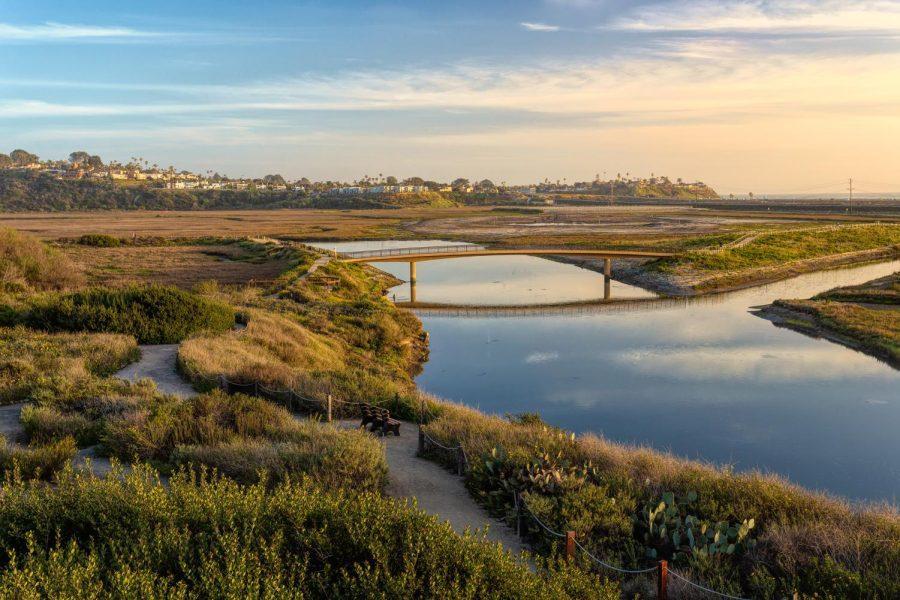San Elijo Lagoon thrives as restoration project enters final phase
A trail bridge at San Elijo Lagoon in Encinitas is shown in 2021, not long after its completion. A lagoon restoration project is entering its final phase in spring 2022. (Photo by Marcel Fuentes, iStock Getty Images)
April 2, 2022
The San Elijo Lagoon Restoration Project is set to complete its fourth and final phase, which involves removal of accumulated sand from the lagoon channel under the new Interstate 5 bridge, and project officials will continue to monitor progress over the next 10 years.
“The San Elijo Lagoon Restoration Project that began in late 2017 will be complete by mid-April 2022,” said Doug Gibson, executive director and principal scientist of the Nature Collective. “One of the project’s goals was to increase tidal circulation in San Elijo Lagoon by widening and straightening the channels, removing years of sand and high-nutrient sediment build-up.”
 Earlier this month, 440,000 cubic yards of sand was piped onto beaches in Cardiff and Fletcher Cove in Solana Beach, completing sand replenishment. Project officials found that the sand-piping process improved tidal flow, growth of native salt marsh, storm flow and overall surf.
Earlier this month, 440,000 cubic yards of sand was piped onto beaches in Cardiff and Fletcher Cove in Solana Beach, completing sand replenishment. Project officials found that the sand-piping process improved tidal flow, growth of native salt marsh, storm flow and overall surf.
“Crews completed pumping sand onto Cardiff State Beach and are currently trucking the last sand to Moonlight Beach in Encinitas,” Gibson said. “The restoration project will be complete when all sand is removed.”
From 7 a.m. to 7 p.m. on weekdays and Saturdays, crews will haul sand from the lagoon to B Street in Encinitas until the remaining sand is removed.
The Nature Collective will measure the progress of the San Elijo Lagoon Restoration Project over the next 10 years to determine if the project has met success standards. It is year three of the restoration project, and scientists are beginning to see progress being made within the ecological reserve.
The work has been part of Build NCC, a consortium of agencies engaged in projects to improve transportation infrastructure and mitigate environmental impacts.
Tim Stillinger, science director of the Nature Collective, said that the original San Elijo Lagoon and Ecological Reserve was developed without the health of the lagoon in mind being that it is located in a dense urban environment.
Stillinger said that widening and deepening the existing channels gives the lagoon a “breath of fresh air” and thus drives productivity of the lagoon. Due to construction on the channels, there is now full tidal flow in the central basin of the lagoon, just west of I-5.
After widening and deepening the channels of the lagoon, there is now one strong patch of eelgrass in the wetland, which can be seen from the new pedestrian bridge near the nature center.
Stillinger described eelgrass as a “canary in a coal mine” because of its sensitivity and difficulty to grow. It is essential for the lagoon to drive diversity and increase the quality of life for all species in and around the reserve, which is why it is crucial to maintain the health of the San Elijo Lagoon once the project is complete.
As the final phase of the San Elijo Restoration Project comes to a close, changes made to the San Elijo Ecological Reserve are becoming much more evident with the help of improved pedestrian walkways and widening work on I-5.
Residents interested in assisting with the project can find opportunities to volunteer with the Nature Collective in Solana Beach. Duties include the removal of invasive plant species, propagation, maintenance and monitoring of plants. Visit www.naturecollective.org/volunteer for more information.
Samantha Cox is a North County freelance writer.
encinitas current, cardiff current




